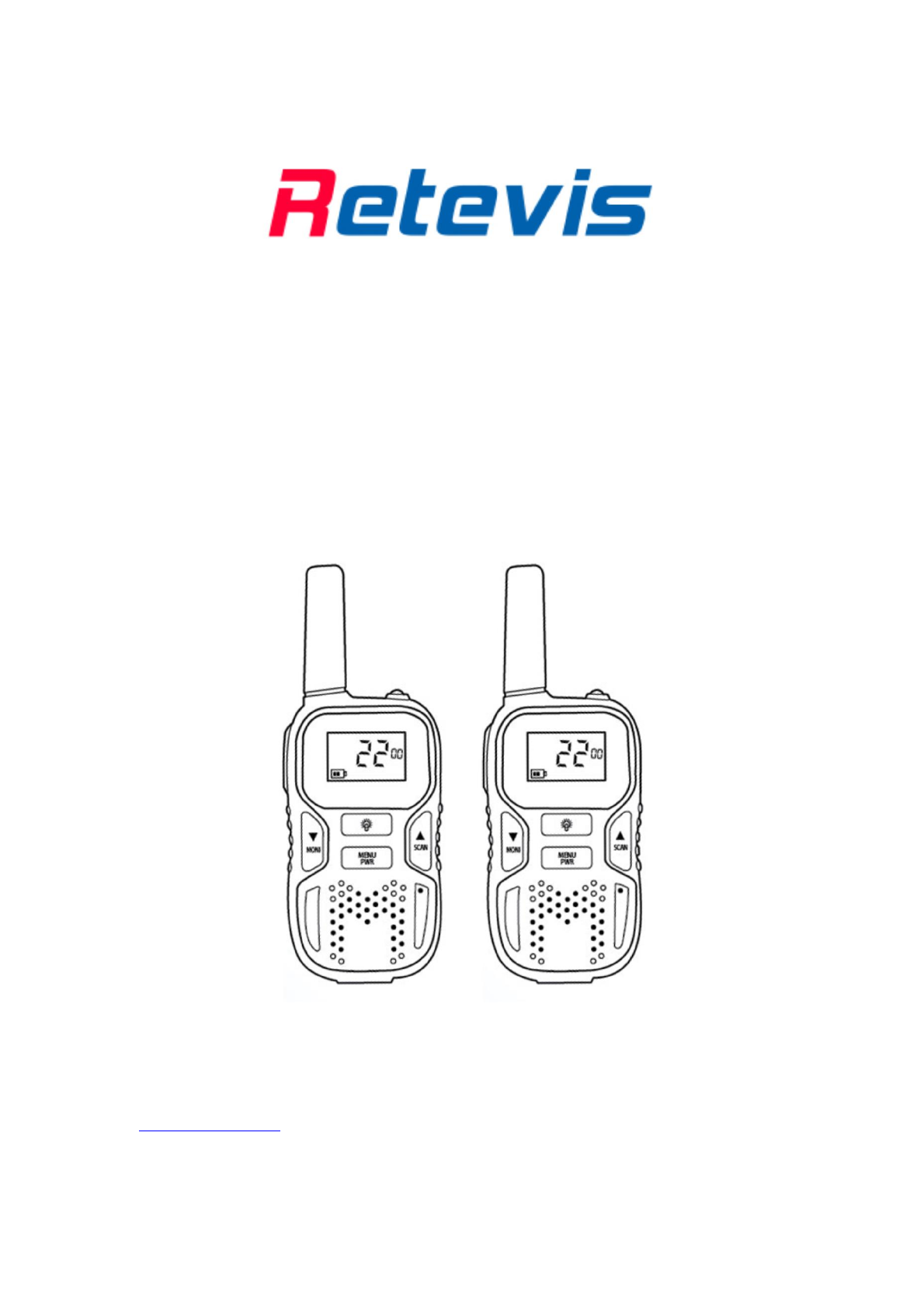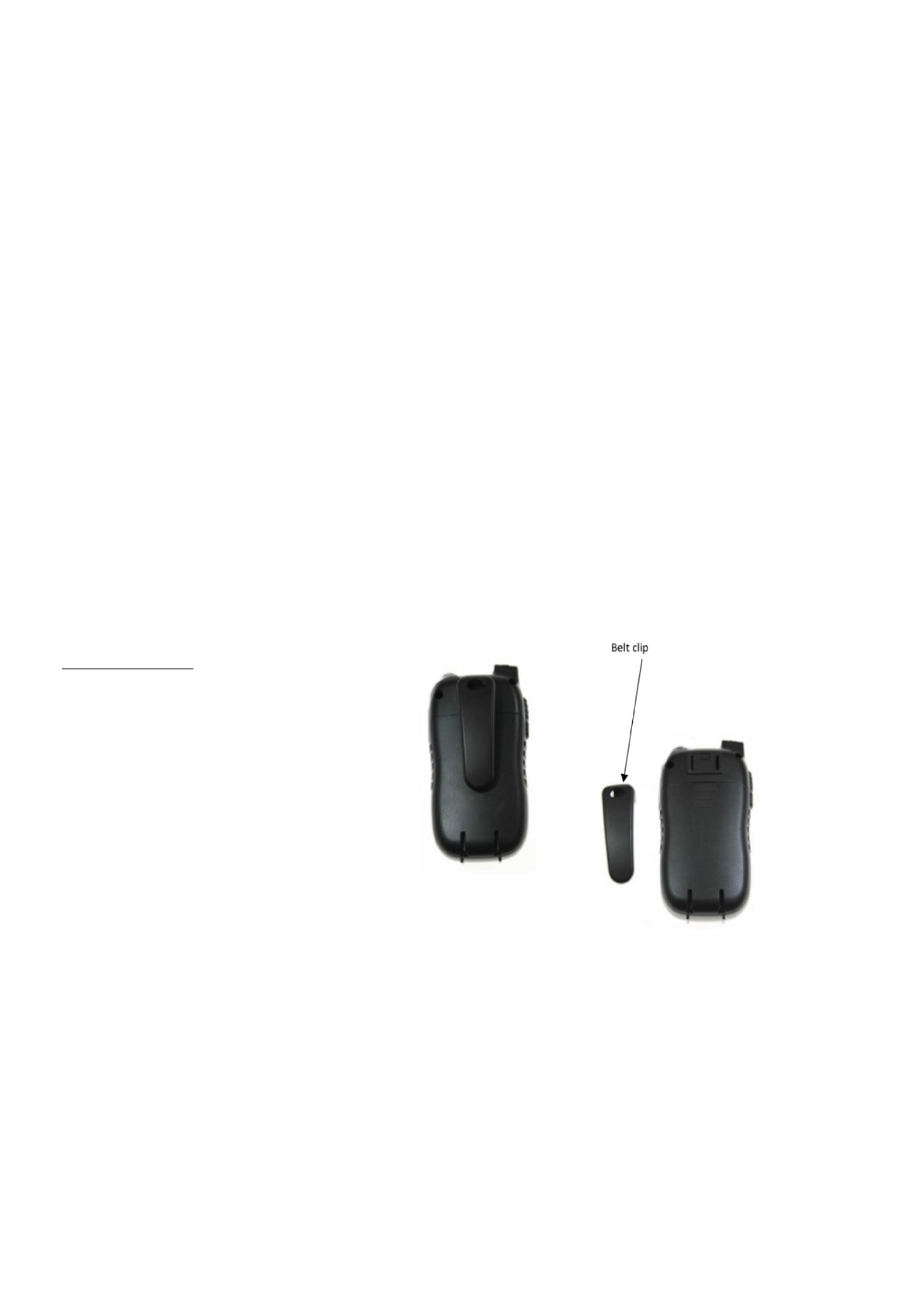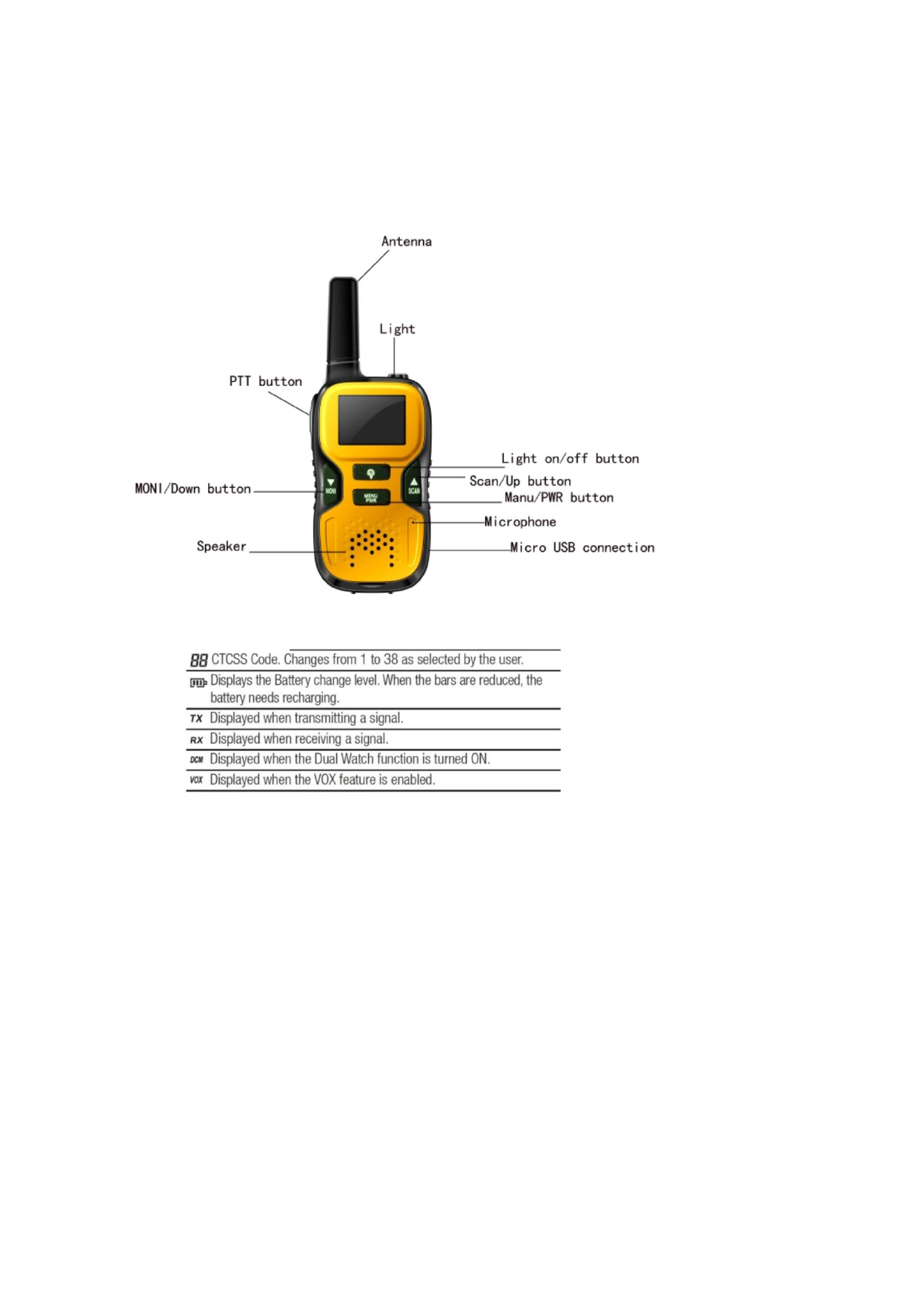HENAN ESHOW ELECTRONIC COMMERCE RETEVISRT33 Walkie Talkie User Manual
HENAN ESHOW ELECTRONIC COMMERCE CO., LTD Walkie Talkie
User manual

User manual
0
.5W Handheld walkie talkie
RT33
Web:www.retevis.com
E-mail:kam@retevis.com
HONGKONG RETEVIS TRADE CO.,LIMITED

Safety Information and Warnings
Information on Safe Operation
Read This Information Before Using Your Radio.
The operation of your radio in Your country is subject to conditions in the following license:
Radio Antenna
Do not use any radio that has a damaged antenna. If a damaged antenna comes in contact with the skin, a minor burn may result.
Unauthorized antennas, modifications, or attachments could damage the radio and violate compliance.
Do NOT change or modify the antenna.
Do NOT hold the antenna when the radio is “IN USE.” Holding the antenna reduces range and may cause bodily harm.
Safety and general use whilst in a vehicle
Check the State and Federal laws and regulations regarding the use of two way radios in the area where you drive,
and always obey them.
For Vehicles fitted with Air Bags
Do not place your radio in the area over an air bag or in the air bag deployment area. Air bags inflate with great force.
If a radio is placed in the air bag deployment area and the air bag inflates, the radio may be propelled with great force and cause
serious injury to the occupants of the vehicle.
Batteries
All batteries can cause property damage and/or bodily injury such as burns if conductive material such as jewellery, keys, or beaded
chains touches exposed terminals. The material may complete an electrical circuit (short circuit) and become quite hot.
Exercise care in handling any charged battery, particularly when placing it inside a pocket, purse, or other container with
metal objects.
Do not replace or charge batteries in a potentially explosive atmosphere. Contact sparking may occur while installing or
removing batteries and cause an explosion.
Potentially Explosive Atmospheres
Turn your radio OFF when in any area with a potentially explosive atmosphere. Sparks in such areas could cause an explosion or fire
resulting in injury or even death.
NOTE: Areas with potentially explosive atmospheres are often, but not always clearly marked.
They include fueling areas such as below deck on boats;
fuel or chemical transfer or storage facilities;
areas where the air contains chemicals or particles, such as grain, dust, or metal powders;
and any other area where you would normally be advised to turn off your vehicle engine.
Blasting Caps and Areas
To avoid possible interference with blasting operations, turn your radio OFF near electrical blasting caps or in a “blasting area” or
in areas posted: “Turn off the two way radio.” Obey all signs and instructions.
Transmit and Receive Procedure
Your two-way radio contains a transmitter and a receiver. To control your exposure and ensure compliance with the general
population/uncontrolled environment exposure limits, always adhere to the following procedure:
•
Transmit no more than 50% of the time. To receive calls, release the PTT button.
To transmit (talk), press the Push to Talk (PTT) button. Transmitting 50% of the time, or less, is
important because the radio generates measurable RF energy exposure only when transmitting (in
terms of measuring standards compliance). Always hold the radio approximately 5cm in front of
your mouth with the antenna pointing away from your head.
Radio Operation and EME Exposure
Unauthorized antennas, modifications, or attachments could damage the radio and violate Compliance.
Do NOT hold the antenna when the radio is “IN USE.” Holding the antenna reduces the effective range.
Do not use the radio if the antenna is damaged. If a damaged antenna makes contact with your skin,
a minor burn can result. If you wear a radio on your body when transmitting, always fit the radio on the
belt clip (supplied). Always ensure the radio and it's antenna are at least 5cm from your body when transmitting.
Electromagnetic Interference/Compatibility

Nearly every electronic device is susceptible to electromagnetic interference (EMI). To avoid the
possibility of electromagnetic interference and/or compatibility conflicts, turn off your radio in any
location where posted notices instruct you to do so such as health care facilities.
Aircraft
When instructed to do so, turn off your radio when onboard an aircraft. Any use of a radio must
be in accordance with applicable regulations per airline crew instructions.
Medical Devices – Pacemakers
The Advanced Medical Technology Association recommends that a minimum separation of 6
inches (15cm) be maintained between a handheld wireless radio and a pacemaker. These
recommendations are consistent with the independent research by and recommendations of
the U.S. Food and Drug Administration. People with pacemakers should:
·
·
·
·
ALWAYS keep the radio more than 15cm from their pacemaker when the radio is turned ON.
Not carry the radio in the breast pocket.
Use the ear opposite the pacemaker to minimise the potential for interference.
Turn the radio OFF immediately if there is any reason to suspect that interference is taking place.
Medical Devices --‐Hearing Aids
Some radios may interfere with some hearing aids. In the event of such interference, you may want to consult your hearing
aid manufacturer to discuss alternatives.
Other Medical Devices
If you use any other personal medical device, consult the manufacturer of your device to determine if it is adequately
shielded from RF energy. Your physician may be able to assist you in obtaining this information.
General warnings
Never use your radio outdoors during a thunderstorm. Keep the radio out of reach of babies and young children.
INSTALLATION
Removing the belt clip
Pull the belt clip latch away from the unit.
Installing the Batteries
FOR USE OF RECHARGEABLE BATTERIES:
If your walkie talkie comes with a rechargeable battery pack or USB cable, dual USB adaptor and dual USB car charger.
The fully charging time is about 12 hours.
The adaptor and car charger will only charge the battery pack provided and not other types of rechargeable batteries.
After placing batteries into correct positions, replace the battery cover.
FOR USE OF NON RECHARGEABLE BATTERIES:
1
2
3
.Slide down the battery compartment cover.
.Insert 3 x AAA batteries (not included).
.Position the batteries according to the polarity marking on the battery compartment. After placing batteries into correct positions,
replace the battery cover.
Low Battery Meter Indicator
The radio can detect the low battery level when the battery voltage goes low. The battery icon will display the low battery status.

When battery voltage is low, the empty battery symbol will appear and continue to blink. The battery symbol will continuously
blink until it totally drains the battery voltage where then you will have to replace the batteries.
Transmitting Range
The talk range will depend on your surroundings and environment it will be affected by obstructions such as hills or buildings.
Don’t try to use two radio units which are less than 1.5m (5 feet) apart. Otherwise, you may experience interference.
Talk range depends on the terrain. It will be affected by concrete structures, heavy foliage and by operating radios
indoors or in vehicles.
Operating the unit
Turning unit on/off:
1
-- Switching on
Press and hold the MENU/PWR until you hear a beep sound.
-- Switching off
2
Press and hold the MENU/PWR until you hear a beep sound.
Adjusting the Volume:
You have 8 preset volume levels. They are displayed on the LCD screen. To raise the volume press the up button (SCAN) and
to decrease the volume, press the down button (MONI).
Auto scan.
Press & hold the UP button for 3 seconds to activate auto scan.
Press Menu/PWR button to deactivate auto scan.
Monitor (Zero squelch)
Press & hold the DOWN button for 3 seconds to activate monitor.
Press & hold the DOWN button for 3 seconds to deactivate monitor.
Changing Channels
You have channels with the legal frequency at your disposal. To communicate with another device,you must both be on the same
channel.To change channels, once you have turned your unit on, you need to press the MENU/PWR once and use the up/down buttons

to scroll through to your desired channel. To set your desired channel, press the PTT button to confirm changes.
Your unit is simplex “one way at a time”. While you are speaking, you can not receive a Transmission.
Your unit is an open--‐license band. Always identify yourself when transmitting on the same channel.
IMPORTANT: Before transmitting on a channel listen to ensure it is not already in use.
CTCSS/DCS
Press the Menu button twice and use the Up/ Down to introduce CTCSS/DCS Continuous Tone--Coded Squelch System
or CTCSS is a circuit that is used to reduce the annoyance of listening to other users on a shared two--way radio
communications channel. It basically allows a private CH on a busy stream.
CTCSS = Coded tone controlled squelching system. This allows you to talk on a private sub channel on an active channel.
DCS is a digital extension of CTCSS.
DCS=DCS is a digital extension of CTCSS.It provides extra,digitally coded,squelch codes that follow after the 38 CTCSS codes.
CTCSS 1 to 38 ,followed by DCS 39-83.
VOX
voice operated transmitter it allows you to transmit with you voice without pressing the button.
Your communicator is equipped with an adjustable Voice Operated Transmitter(VOX) that can be used for automatic voice
transmission.
In this convenient mode,transmission is automatically initiated by speaking in to the microphone.There is no need to push the Button.
By press MENU button 3 times,screen will display VX character,character OF keep flashing,Press UP or Down button to select voice
level
(from 1 to 3 level),by press PTT button to confirm setting.VOX Default setting as off
CA = call allows you to adjust different tones for calling the operator from the same channel.
Press Menu button 4 times,screen will display CALL character,digital 01 keep flashing,by press UP or down button to select call tone
from01~10,press PTT button to confirm call tone setting.Default setting for call tone is 01
There are 10 mode call tone in this unit,you and other party can use designed call tone to communicate separately,secretly to avoid
any disturb.You can press PTT button twice quickly to send a tone to other users on the same channel. To activate this feature.
With the unit in normal mode, press twice quickly and release the PTT button. The unit will transmit a 2--second page tone
to the other unit/s set with the same channel within transmitting range.
NOTE: This function is only possible every 60 seconds.
TO
time out is when the unit turns off after 30sec or 60sec when activated.
Press Menu button 5 times,screen will display 60 TO,press UP or Down can choose 60 or 30 seconds or OF.Default setting is 60
seconds,press the PTT button to confirm changes.
Roger Beep
roger beep means a tone added to the end of broadcast, it indicates that the user/operator has conclude speaking.
This is a tone which is automatically transmitted whenever the PTT button is released.
This alerts the receiving party that you have ended the transmission, and you are now in receive mode.
Press Menu button 6 times,screen will display ON RO,press UP or down to choose RO OF or ON,press the PTT button
to confirm changes.
BELL
symbol on the display = turn off/on the beep when using any buttons.
Press Menu button 7 times,screen will display Bell ON,press UP to choose ON or down to choose OF.Default setting is ON
press the PTT button to confirm changes.
DCM
dual channel monitoring you can monitor between two channels eg: 1 to 8or 9 to22.
Press Menu button 8 times,screen will display DCM OF,press Down or UP to choose DCM ON or OF,press the PTT
button to confirm changes.
Transmitting (sending speech)
The unit is continuously in the Receive mode when the unit is turned ON and not transmitting.
When a signal is received on the current channel, “RX” icon will be displayed on the LCD screen.
a.Press and hold the PTT (Push to Talk) button to transmit your voice. The transmit signal icon “TX”

will display on the LCD screen.
b. Hold the unit in a vertical position with the Mic (Microphone) 5cm away from the mouth. While holding the PTT button,
speak into the microphone in a normal tone of voice.
c. Release the PTT button when you have finished transmitting.
For others to receive your transmission, they must be on the same channel as you.
Channel and Frequency (MHz)
Europe(8CH)
Ch.
Frequency
446.00625
446.01875
446.03125
Ch.
Frequency
Ch.
Frequency
1
2
3
4
5
6
446.04375
446.05625
446.06875
7
8
446.08125
446.09375
USA(22CH)
Ch.
Frequency
Ch.
Frequency
Ch.
Frequency
Ch.
Frequency
1
2
3
4
5
6
462.5625
462.5875
462.6125
462.6375
462.6625
462.6875
7
8
9
10
11
12
462.7125
467.5625
467.5875
467.6125
467.6375
467.6625
13
14
15
16
17
18
467.6875
467.7125
462.5500
462.5750
462.6000
462.6250
19
20
21
22
462.6500
462.6750
462.7000
462.7250
Japan(20CH)
Ch.
Frequency
Ch.
Frequency
Ch.
Frequency
Ch.
Frequency
1
2
3
4
5
6
422.0500
422.0625
422.0750
422.0875
422.1000
422.1125
7
8
9
10
11
12
422.1250
422.1375
422.1500
422.1625
422.1750
422.2000
13
14
15
16
17
18
422.2125
422.2250
422.2375
422.2500
422.2625
422.2750
19
20
422.2875
422.3000
P.R. China (20CH)
Ch. Frequency
Ch. Frequency
Ch. Frequency
Ch. Frequency
1
2
3
4
5
6
409.7500
409.7625
409.7750
409.7875
409.8000
409.8125
7
8
9
10 409.8625
11 409.8750
12 409.8875
409.8250
409.8375
409.8500
13 409.9000
14 409.9125
15 409.9250
16 409.9375
17 409.9500
18 409.9625
19 409.9750
20 409.9875
IRAN(35CH)
Ch.
Frequency
Ch.
Frequency
Ch.
Frequency
Ch.
Frequency
1
2
3
4
5
6
7
8
9
433.0625
433.0750
433.0875
433.1000
433.1125
433.1250
433.1375
433.1500
433.1625
10
11
12
13
14
15
16
17
18
433.1750
433.1875
433.2000
433.2125
433.2250
433.2375
433.2500
433.2625
433.2750
19
20
21
22
23
24
25
26
27
433.2875
433.3000
433.3125
433.3250
433.3375
433.3500
433.3625
433.3750
433.3875
28
29
30
31
32
33
34
35
433.4000
433.4125
433.4250
433.4375
433.4500
433.4625
433.4750
433.4875
Product Safety and RF Exposure
This device complies with part 15 of the FCC Rules. Operation is subject to the following two conditions:
1.This device may not cause harmful interference.
2.This device must accept any interference received, including interference that may cause undesired operation.
FCC Caution:
Caution: To maintain compliance with the FCC’s RF exposure guidelines hold the transmitter and antenna at least 1 inch (2.5
centimeters) from your face and speak in a normal voice, with the antenna pointed up and away from the face, use only the
supplied belt chip for this product and transmitting, use of other accessories may not ensure compliance with FCC RF
exposure guidelines.
This equipment complies with FCC radiation exposure limits set forth for uncontrolled environment. Unauthorized antennas,
modification, or attachments could damage the transmitter and may violate FCC regulations
The device is authorized to operate at a duty factor not to exceed 50%.
Hazardous Environments:
Do not operate the communicator in hazardous environments, explosion or fire may result. Do not operate the communicator
near unshielded electrical blasting caps. Under certain conditions, radios can interfere with blasting operations and may cause
an explosion. Turn your radio to the OFF position to prevent accidental transmission when in a blasting area or in areas
posted: “Turn off two-way radios.” Construction crews often use remote control RF devices to set off explosives.
Never use cleaners or solvents to clean your device. Use a dry, lint-free cloth to clean the battery contacts. Do not submerge
the unit in water.